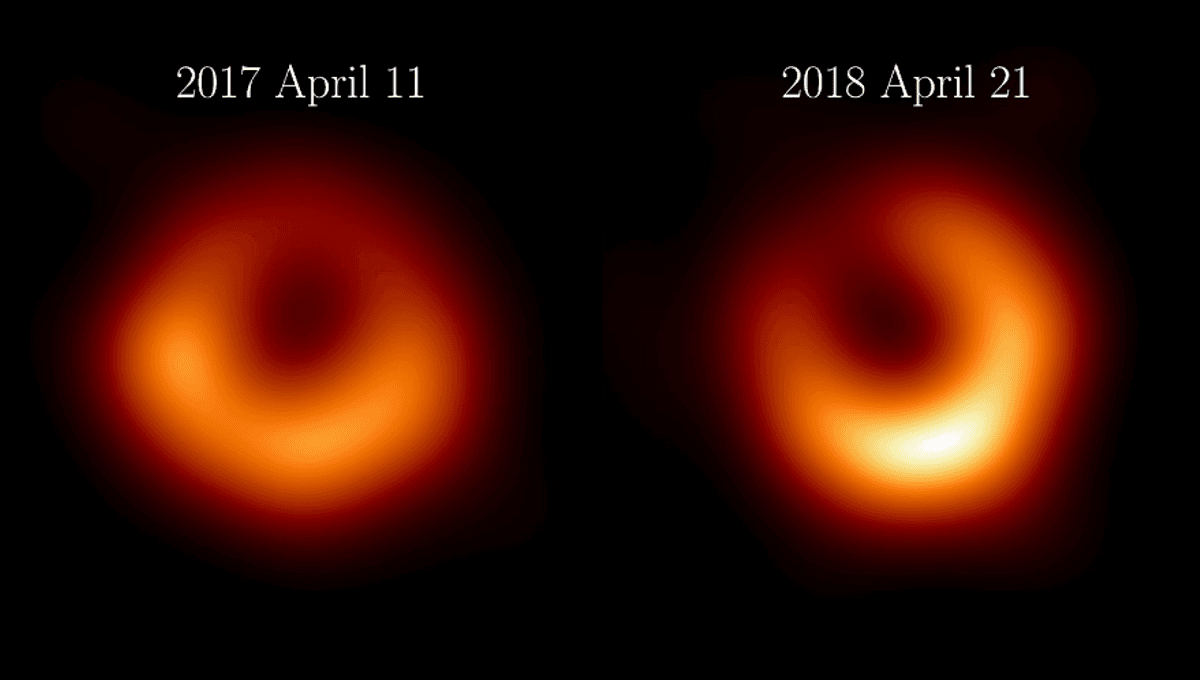
In 2017, researchers used a virtual telescope the size of our planet to image the shadow of a supermassive black hole for the first time. The image was of M87*, the black hole at the center of galaxy Messier 87, and was the first image of the shadow of the event horizon and bright accretion disk around a black hole ever taken. Now the team has released a new image of M87* from observations conducted a year later that show the shadow is not only a persistent feature, as predicted, but that the brightness of the ring has changed.
The Event Horizon Telescope (EHT) team used eight independent imaging and modeling techniques to analyze the data from the April 2018 observations and found the brightness peak of the orange disk has shifted by about 30 degrees counterclockwise – now at the 5 o’clock position, which can be seen in the image above on the right – compared to that seen in 2017, while the size of the ring and the shadow are unchanged, as general relativity predicted.
“Confirmation of the ring in a completely new data set is a huge milestone for our collaboration and a strong indication that we are looking at a black hole shadow and the material orbiting around it,” Dr Keiichi Asada of the Academia Sinica Institute for Astronomy and Astrophysics in Taiwan said in a statement.
M87* weighs 6.5 billion times the mass of our Sun and is located 53.5 million light-years away. The shift in the brightness spot seen in the new observations was predicted, the idea being that the emission from the turbulent, messy accretion disk around the supermassive black hole – full of material that couldn’t escape the black hole’s gravitational pull – will cause the brightest part to wobble. The wobble can be used to test our theories about the behavior of the magnetic field and plasma around the black hole.
The EHT images of these incredible objects are possible thanks to a fantastic property of light. Observations from radio telescopes that are a certain distance apart can be combined in a way that is equivalent to a telescope the size of their distance. By combining radio telescopes around the world, the initial 2017 EHT was the size of our planet. For the 2018 observations, new telescopes in Greenland and Mexico had been added, and even more have been added since.
“The inclusion of the Greenland Telescope in our array filled critical gaps in our earth-sized telescope,” Rohan Dahale, a PhD candidate at the Instituto de Astrofísica de Andalucía. “The 2021, 2022, and the forthcoming 2024 observations witness improvements to the array, fuelling our enthusiasm to push the frontiers of black hole astrophysics.”
In 2022 we got the first image of our own galaxy’s supermasive black hole, Sagitarrius A*, and in 2023 the first direct image of a black hole launching its jets, as well as an AI-sharpened M87* glow up. With every new image or details revealed, and more telescopes adding to the size and capabilities of the EHT, the question is: what are we zooming in on next?
The study is published in the journal Astronomy & Astrophysics.
Source Link: Brand New Image Of First Black Hole To Be Photographed Reveals Moving Shadow